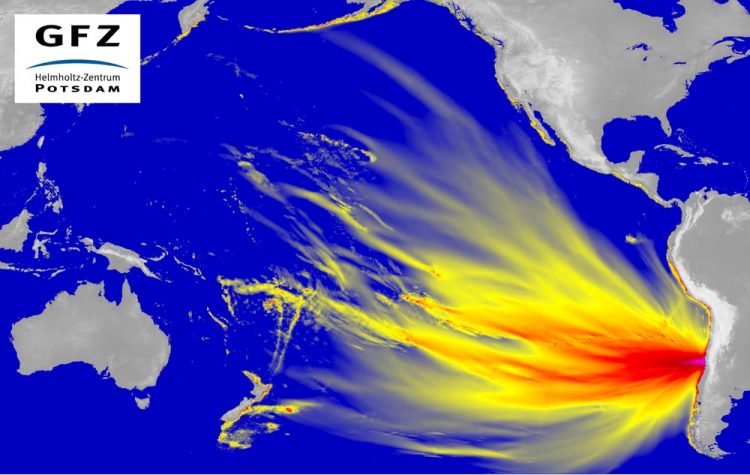Strong Earthquake in Chile and Tsunami

Tsunami simulation off the Chile Coast, for the earthquake on 16 September 2015, Pacific View (A. Babeyko, GFZ).
The very strong earthquake with a magnitude of 8.2 which occurred on the evening of 16.9.2015 (local time) hit a part of the Chilean coastline that was last shook by an earthquake of almost the same magnitude on 6.4.1943.
Information on casualties and damage is still incomplete. It appears, however, that the quake has been comparatively harmless, mainly, among other factors, because the warning based on scientific research was taken seriously.
The Nazca Plate, a part of the Pacific Earth crust moves along the South American crust at a rate of approx. 6.8 centimeters per year pushing under the continent in the process. The repeated interlocking and breaking apart on the boundary surface between both plates has been controlling this procedure over several 100 million years.
Only in 2010, a little further south of the current rupture and just before the second largest Chilean city of Concepcion, an earthquake occurred, which with a magnitude of 8.8, was one of the five strongest earthquakes that was recorded since the start of seismological monitoring.
Following this event, in which 500 people lost their lives – mainly due to the resulting tsunami – the Chilean State began to set up a nationwide network of seismological and GPS stations. The godfather of this activity was the Earthquake Observatory IPOC in North Chile (ipoc-network.org) which had been previously jointly developed by the GFZ German Research Centre for Geosciences in cooperation with French partners.
“The aim of IPOC was to test new observation technologies and to carry out research on earthquakes and volcanos”, explains Professor Onno Oncken of the GFZ. “The observation and measuring stations developed here served as the blueprint for a network that meanwhile, with a total length of about 4000 kilometers, virtually covers the whole Chilean coastline.”
This observation system which is operated by a state organization founded especially for this purpose has now, for the first time, been able to prove its performance capability. Yesterday’s earthquake triggered a tsunami; however, a warning had already been very quickly and successfully issued.
The expected waves reaching three to four metres above sea level were observed at numerous coastal stations, parts of Coquimbo, the largest city in this section of the coast north of Valparaiso, are flooded. The actual number of casualties is not yet known so soon after such an event, however, we can assume that the Chilean Early Warning System has successfully functioned.
Graphic sketch of the tsunami propagation model in the eastern Pacific is here:
http://www.gfz-potsdam.de/en/media-communication/mediathek/image-galleries/earth…
Picture and information of the location and magnitude of the main shock: http://geofon.gfz-potsdam.de/eqinfo/event.php?id=gfz2015sfdd
Aftershock activity: http://geofon.gfz-potsdam.de/eqinfo/list.php
How to behave in case of strong quakes and tsunami? http://www.gfz-potsdam.de/en/media-communication/current-earthquake-information/
Media Contact
All latest news from the category: Earth Sciences
Earth Sciences (also referred to as Geosciences), which deals with basic issues surrounding our planet, plays a vital role in the area of energy and raw materials supply.
Earth Sciences comprises subjects such as geology, geography, geological informatics, paleontology, mineralogy, petrography, crystallography, geophysics, geodesy, glaciology, cartography, photogrammetry, meteorology and seismology, early-warning systems, earthquake research and polar research.
Newest articles

Properties of new materials for microchips
… can now be measured well. Reseachers of Delft University of Technology demonstrated measuring performance properties of ultrathin silicon membranes. Making ever smaller and more powerful chips requires new ultrathin…

Floating solar’s potential
… to support sustainable development by addressing climate, water, and energy goals holistically. A new study published this week in Nature Energy raises the potential for floating solar photovoltaics (FPV)…

Skyrmions move at record speeds
… a step towards the computing of the future. An international research team led by scientists from the CNRS1 has discovered that the magnetic nanobubbles2 known as skyrmions can be…




















